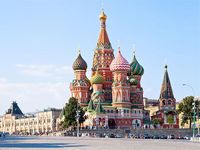 Moscow Moscow
Russia’s political and financial capital as well as a cultural center. The city includes several must see attractions from the Kremlin and the Red Square to the Assumption Cathedral. Moscow is the largest city in Europe complete with everything one could expect.
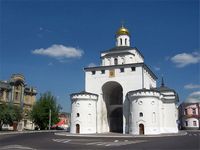 Vladimir: 209 km; 2h 30min. Vladimir: 209 km; 2h 30min.
Built on the Klyza’ma River, Vladimir, founded in 995, was at one time a capital of Russia and its political, cultural and religious center. Vladimir is a part of the Golden ring of the ancient Russian cities. Its three main monuments, among which are, the Assumption Cathedral with magnificent Andrei Rublev's frescos and St. Dmitrii Cathedral were erected more than 800 years ago and The Golden Gate are inscribed by UNESCO on the World Heritage List.
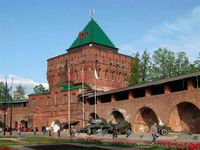 Nizhny Novgorod: 461 km; 6h 30 min. Nizhny Novgorod: 461 km; 6h 30 min.
At the confluence of the Oka and the Volga Rivers, Nizhny Novgorod (formerly named Gorky), founded in 1221, is the 4th largest city in Russia. Although it dates back to the 13th century, the majority of its most interesting sights are since later periods. The foremost among these is the city’s great brooding Kremlin built during the 16th century. Until quite recently it was a closed city, best known to foreigners as a place of political exiles.
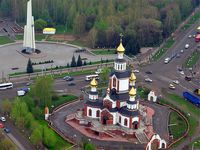 Kirov: 917 km; 12h 50 min. Kirov: 917 km; 12h 50 min.
Kirov has a population of 350,000 and is the seat of a great agricultural center on the banks of the Vyatka River, a navigable river that connects with the Volga.
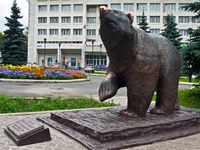 Perm: 1397 km; 20h 10 min. Perm: 1397 km; 20h 10 min.
Perm lies on the western slopes of the Ural Mountains, and stretches along both sides of the Kama River. Perm was founded in the 16th century. Since the 18th century Perm has been a center for Russia’s military manufacturing. Actually since that time it was established as the administrative center of the northern Urals and a gateway to Siberia.
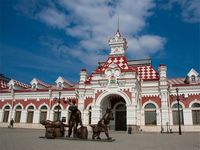 Ekaterinburg (Sverdlovsk): 1778 km; 1d 2h 20min. Ekaterinburg (Sverdlovsk): 1778 km; 1d 2h 20min.
Russia’s third largest city and the capital of the Urals. Sverdlovsk oblast is one of the most developed and advanced regions in Russia. It is very rich in minerals and raw materials and is a heavily industrialized area. Ekaterinburg was founded in 1723 and named after Tzar Peter the Great’s wife the Empress Catherine I (Ekaterina). Soon after the Russian Revolution took place Tsar Nicolas II with his family were executed by the Bolsheviks at the Ipatiev House where they were held prisoner and later killed. Ekaterinburg is also famous for its location directly on the border between Europe and Asia.
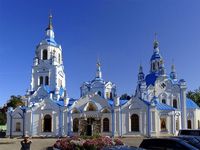 Tyumen: 2104 km; 1d 6h 30min. Tyumen: 2104 km; 1d 6h 30min.
Tyumen was the first Russian town in Siberia and has always been famous for its rich trade fairs and skilled craftsmen. Today it is an oil and gas capital.
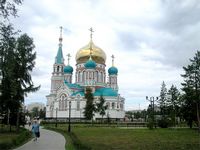 Omsk: 2676 km; 1d 13h 50min. Omsk: 2676 km; 1d 13h 50min.
Originally built as a fortification for Russia’s southern border by Peter the Great's guardsman Ivan Buchholz; when in spring of 1716 he and his detachment made a landing on the shore of Irtysh, at the place where this powerful Siberian river joins the quiet Om river. Thus, the town of Omsk was founded, which has become the largest industrial and cultural center in Siberia.
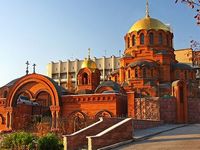 Novosibirsk: 3303 km; 1d 21h 30min. Novosibirsk: 3303 km; 1d 21h 30min.
The Siberia region’s largest city was founded in 1893. Novosibirsk is the third main cultural and scientific center in Russia (after Moscow and St. Petersburg) and also is home to the famous University of Novosibirsk. The city is developing rather rapidly, and is considered to be the capital of Siberia. The area around Novosibirsk and the Altai Mountains hold some incredible nature for the outdoorsmen.
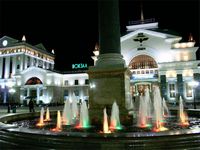 Krasnoyarsk: 4065 km; 2d 9h 20 min. Krasnoyarsk: 4065 km; 2d 9h 20 min.
Krasnoyarsk is turning into one of the most attractive regions in Russia for both Russian and foreign tourists. The region offers a unique combination of beautiful rivers and mountains, pure air, hunting and fishing, architectural sites and the ethnic culture of the unique northern nation.
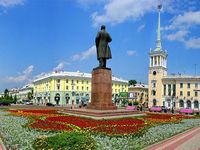 Angarsk: 5113 km; 3d 2h 20min. Angarsk: 5113 km; 3d 2h 20min.
A hazardous city with unsightly landscapes. Recently the construction of an oil pipeline between Russia and China, which would begin in Angarsk, has been discussed.
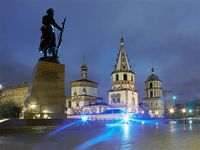 Irkutsk: 5153 km; 3d 3h 20min. Irkutsk: 5153 km; 3d 3h 20min.
Irkutsk has over 600,000 people and is located on the Angara River. It is the starting point for many who adventure to the Lake Baikal area because it is a major point on the Trans-Siberian/Trans-Mongolian train route. Founded by Russians in 1652 as a major fort beyond the Ural Mountains, it was populated by exiled political prisoners sent out by the tzars and communists. Today, the city has become a college town with many young people attending universities there.
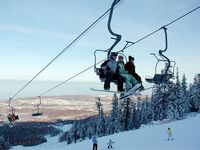 Baikalsk: 5360 km; 3d 6h 40min. Baikalsk: 5360 km; 3d 6h 40min.
Baikalsk is home to a popular ski and snowboard resort.
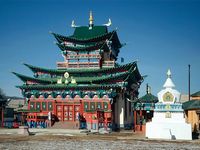 Ulan-Ude: 5609 km; 3d 12h 20min. Ulan-Ude: 5609 km; 3d 12h 20min.
Ulan-Ude, founded in 1666, is a capital of the Buryat Autonomous Republic, which in the 13th - 17th centuries was a part of the vast Mongolian Empire. It is a classic example of the Eastern influence in Russia. In Ulan-Ude, the Trans-Siberian railroad splits into two different directions:
1) travels South though Guisinoye Ozero, Djida, Naushki (Russia) to Ulan-Bataar (Mongolia) and then to Beijing (China) – Trans Mongolian.
2) travels East through Chita to Vladivostok – Trans-Siberian.
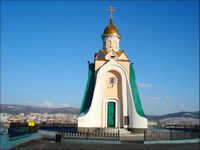 Chita: 6166 km; 3d 21h 50min. Chita: 6166 km; 3d 21h 50min.
A large industrial city and the center of the Chita region. 100 km from Chita (in Karymskaya) the Trans-Siberian railroad splits into 2 routes:
1) East to Vladivostok, and
2) South through Manchuria to China (Trans-Manchurian).
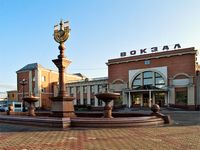 Birobidzhan: 8320 km; 5d 13h 20min. Birobidzhan: 8320 km; 5d 13h 20min.
- Evreiskaya region ends and Khabarovsky krai begins at 8481 km.
- Crosses the Amur River at 8482 via the longest Trans-Siberian bridge (2612 meters) followed by a long tunnel.
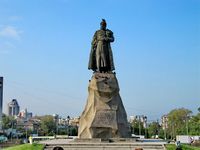 Khabarovsk: 8493 km; 5d 15h 40min. Khabarovsk: 8493 km; 5d 15h 40min.
Located on the Amur River which bounds Russia and China, it is a nice, friendly town and a good break from the time on the train.
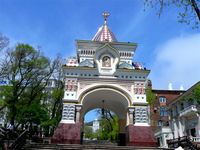 Vladivostok: 9259 km; 6d 5h 19min. Vladivostok: 9259 km; 6d 5h 19min.
The termination of the Trans-Siberian Railway. In 1860, an army squad landed on the bank of the Zolotoy Rog (Golden Horn) bay and built barracks; they were the first buildings in Vladivostok. Soon after that, Vladivostok became the main Russian port on the Pacific Ocean.
|
|
Highlights on the Trans-Sib
Kazan is the capital of the Republic of Tatarstan and the major port on the left bank of Volga. It is one of the largest political, economic, educational, industrial, commercial and tourist centers in Russia. Modern Kazan, as before, is one of the centers of multinational culture in Russia. The interpenetration of the western and eastern mentality in Kazan creates an original independent communicational culture, which can be met only here. More than 115 nationalities live in Kazan, though the Tatars and Russians account for the major part of the city’s population. The amazing architectural appearance of the capital of the Republic of Tatarstan managed to combine two religions: Orthodoxy and Islam. The Kazan Kremlin is included into the UNESCO World Heritage, and the Kul-Sharif Mosque located inside the Kremlin is the main Juma Mosque of the Republic of Tatarstan. One of the main landmarks of Kazan is the “falling” Syuyumbike Tower. Built in the XVII-XVIII centuries, the tower has almost a 2-meter deviation in its apex. Kazan is the city with an amazing millenary history with many architectural monuments extant up to date. A developed infrastructure and wonderful cultural heritage make it attractive for travelers.
Ekaterinburg is the fourth-largest city in Russia, the capital of Ural. It is located in the middle of the Eurasian continent, on the border of Europe and Asia with population of round 1,5 million people. Nowadays the city is an important centre of industry, transport, finance, science and culture. The time zone of Ekaterinburg is UTC+6 (two hours ahead of Moscow and six hours ahead of Greenwich). A flight from Moscow to Ekaterinburg takes two hours, while a train trip takes 25 hours. There is an international airport (regular flights to several destinations in Europe (Prague, Koln, Varna), China, Israel, Cyprus, Turkey, Egypt and the United Arab Emirates.
Ekaterinburg was founded in 1723 by Tzar Peter the Great and named after his wife, Ekaterina. The city witnessed the death of monarchy in Russia, as it was there that the last Russian Tzar Nicolas II with his family was assassinated, at the Ipatiev house by the Bolsheviks on July 16, 1918. You can go on an excursion devoted to these dramatic events.
The unique location of Ekaterinburg gives you an opportunity to visit the border between Europe and Asia. You can visit the mountain Berezovaya – the highest point of the Ural mountains near Ekaterinburg, which is considered to be the border. You can see the special obelisk that marks the border and take photos of your one leg in Europe and another one in Asia.
Novosibirsk is situated in the south part of the West Siberia, on the banks of the Ob River. The city takes the third place in population in Russia after Moscow and Saint-Petersburg. Novosibirsk is a center of the Russian science. Novosibirsk is the youngest among the largest Siberian cities, it is a little more than 100 years old. A rapid development and a title of the largest industrial, economical and cultural center of Russia Novosibirsk gained due to its advantageous location on the Trans-Siberian Railway. So, Novosibirsk became a very large traffic centre. Novosibirsk became famous for its role in the field of science. The Academic town of Novosibirsk is famous all over the world as one of the biggest Russian science centers. 14 most prestigious universities of the country are located here. Novosibirsk is a center of Siberian federal district and big industrial city, where mechanical engineering, power industry, metallurgy and food industry are widely developed. Novosibirsk is also well-know as a large center for arts. A lot of brilliant musicians, singers, ballet dancers, actors and artists have grown up here. Although the city is rather young, there are 145 monuments of architecture, history and archeology, which are protected by the State. The monuments of wooden architecture of XIX - XX centuries are of a special value.
Omsk once was the capital of Siberia. The city is located in the West Siberia on the Irtysh River. The history of Omsk is not so ancient, but nevertheless, is full of drama. It was established in the XVIII century, by an order of Peter the Great while seeking gold deposits in those lands. Almost a century later Omsk became the regional center of the West Siberian governor generalship. The turning point in the city’s life was during the Civil War, when Omsk became a deployment place for the White Guards. In the Soviet period Omsk was the largest industrial center of Siberia. Modern Omsk takes the 7th place by popularity in Russia. It is the center of oil, chemical and petrochemical, energy industries. Russia's largest engineering and metalworking companies are located there. There is a large number of historical, cultural and architectural monuments in Omsk. Omsk is a city of churches, cathedrals, merchant houses and ‘art nouveau’ buildings of the early XX century. The recently restored Uspenskii Assumption Cathedral crowns those marvelous creations.
Krasnoyarsk. A real Siberian megapolis, a city on the mighty Yenisei River and an outpost of the conquest of Siberia – all this is about Krasnoyarsk, a city with a dramatic destiny, which managed to become one of the major economic centers as well as beauty and pride of the entire Siberian region. It was founded in 1628, when a Cossack detachment built the fort which had served as a border fortress for nearly a hundred years. In 1690, when Siberia finally joined Russia, the Krasnoyarsk fort was granted a city status. Having become an important glue in the main trade route of Siberia, in the XVIII century, Krasnoyarsk began to develop actively as a trade and craft center, a large gold-mining center. Today Krasnoyarsk is the largest industrial and cultural center of the East Siberia. The city is divided into two parts by the Yenisei river. The left bank located on the upper terraces of the Yenisei river is particularly picturesque. This is the center of ancient Krasnoyarsk. The unique buildings of the XVIII-XIX centuries have been preserved here. Architecture of the XX century is presented by buildings of the Stalin’s era, the so-called ‘Stalin's Empire style’. Strelka is considered to be the historical city center.
Ulan-Ude, the capital of Buryatia, and one of the most prominent historical cities of Russia. Here, as if in a clew of yarn, the strands of Asia and Europe, roots of Russian and Mongolian peoples, historical monuments and modern buildings have firmly intertwined. Three major ethnicities live in this region: Evenks (natives of this republic), Buryats (a Mongolian tribe that traditionally follows Tibetan Buddhism), and Russians.
Both Buddhist monks in orange robes made of a single-piece fabric and Orthodox priests dressed in black cassocks walk with perfect calm along the same streets. Also harmoniously, Orthodox churches neighbor with ornate Buddhist temples in Ulan-Ude. Today Ulan-Ude is the industrial, scientific and cultural center of the East Siberia. Ulan-Ude still has many buildings of XVIII and XIX centuries, Buryatiya is the center of the Russian Buddhism. Not far away from Ulan-Ude, next to the village Ivolga, there is the largest Buddhist monastery in Russia — Dazan. Ulan-Ude city is an important railway junction because of its location on the Trans-Siberian Railway between the cities of Chita and Irkutsk. The Trans-Mongolian Railway starts in Ulan-Ude and goes through Mongolia to China’s capital city of Beijing. |
